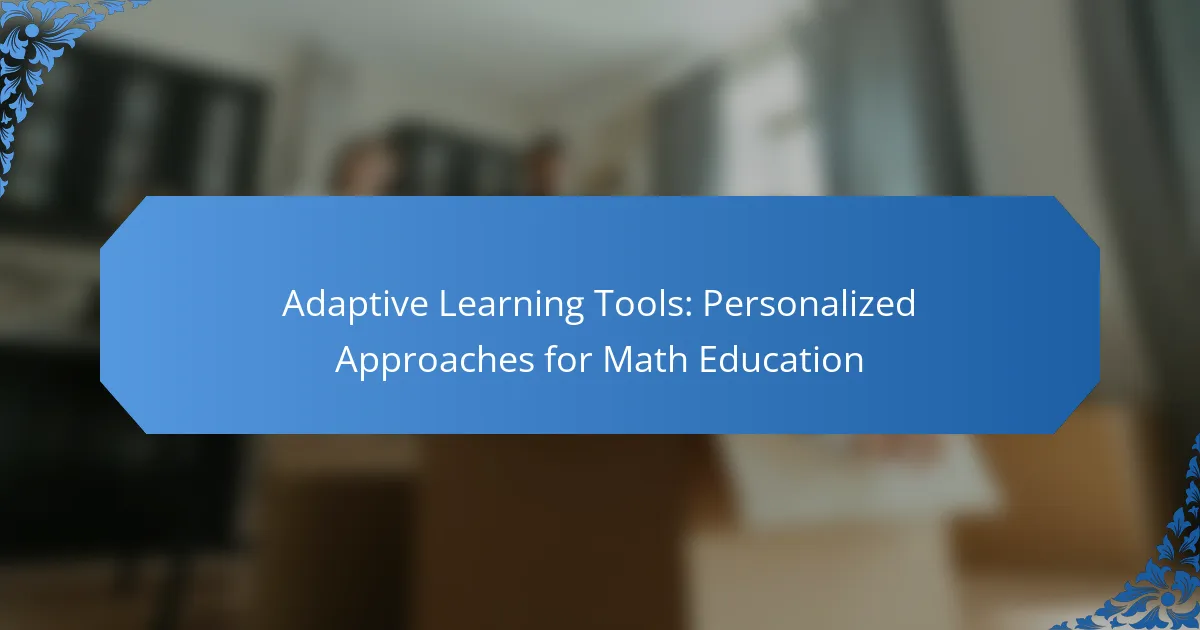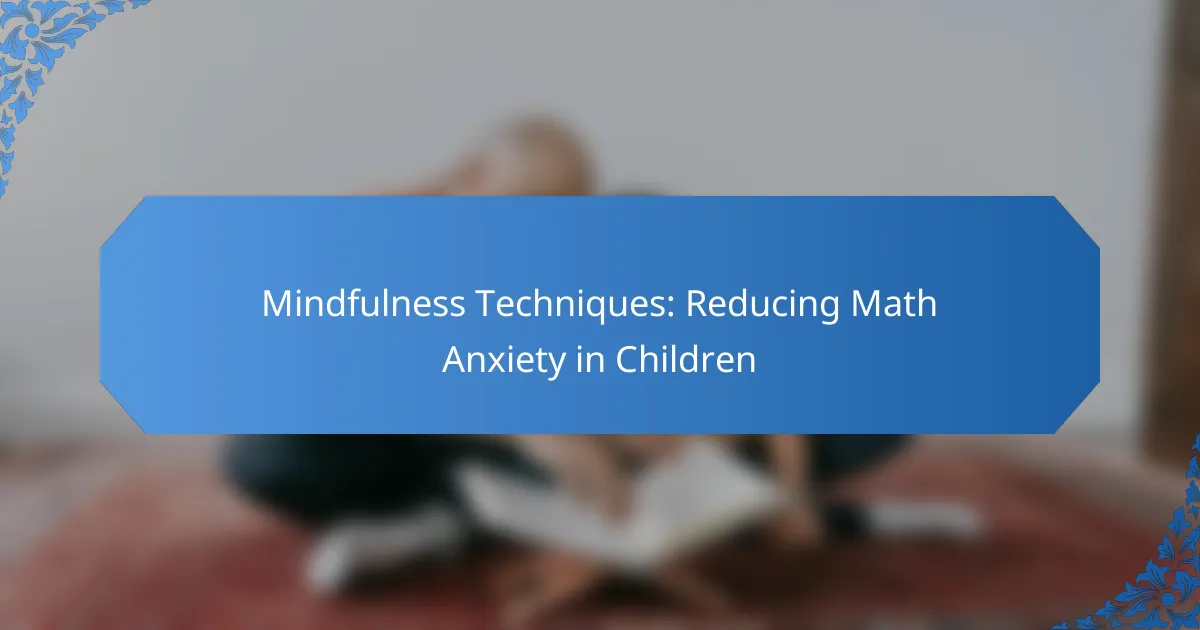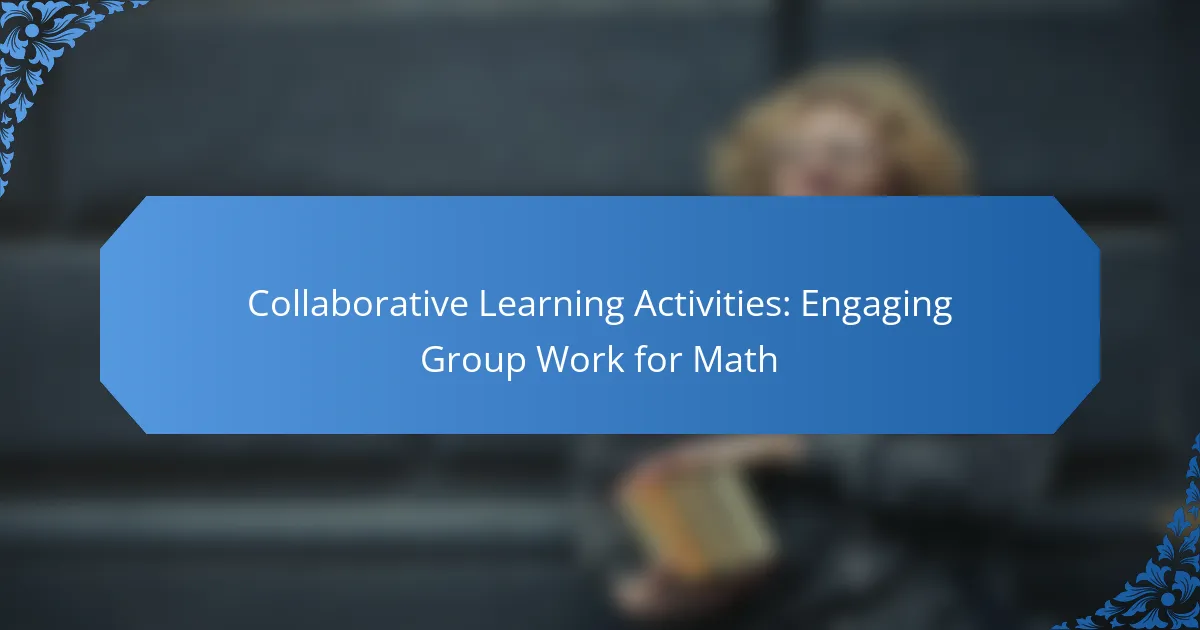Adaptive learning tools in math education revolutionize the learning experience by personalizing content to fit each student’s unique performance and needs. By leveraging advanced algorithms and data analytics, these tools identify individual strengths and weaknesses, providing tailored support that enhances understanding and retention of mathematical concepts.

What Are the Best Adaptive Learning Tools for Math Education?
The best adaptive learning tools for math education personalize the learning experience by adjusting content based on individual student performance. These tools utilize algorithms and data analytics to identify strengths and weaknesses, ensuring that each learner receives tailored support and resources.
Knewton Alta
Knewton Alta is an adaptive learning platform designed to enhance student engagement in math through personalized learning paths. It assesses students’ knowledge in real-time and adjusts the curriculum accordingly, providing targeted practice and resources based on their unique needs.
This tool is particularly beneficial for higher education institutions, as it aligns with various curricula and can integrate seamlessly into existing course structures. Educators can track student progress and identify areas needing additional support, ensuring a more effective learning experience.
DreamBox Learning
DreamBox Learning focuses on K-8 math education, offering an interactive platform that adapts to each student’s learning pace. The software uses a combination of formative assessments and real-time data to modify lessons, ensuring that students are challenged appropriately.
With engaging visuals and game-like elements, DreamBox keeps students motivated while they learn. Teachers can access detailed reports to monitor progress and adjust instruction based on the insights provided by the platform.
Smart Sparrow
Smart Sparrow provides adaptive elearning solutions that allow educators to create personalized learning experiences in math. The platform enables teachers to design interactive lessons that adapt based on student responses, offering immediate feedback and alternative pathways for learning.
This tool is especially useful for higher education settings, where complex math concepts can be broken down into manageable segments. Instructors can analyze student data to refine their teaching strategies and improve overall comprehension.
IXL Learning
IXL Learning offers a comprehensive K-12 math program that adapts to individual student performance through a vast library of practice problems. The platform provides immediate feedback and detailed explanations, helping students understand their mistakes and learn from them.
IXL’s analytics dashboard allows educators to track student progress over time, identifying trends and areas for improvement. The tool is designed to align with state standards, making it a practical choice for schools looking to enhance their math curriculum.
McGraw-Hill Connect
McGraw-Hill Connect is an adaptive learning platform that supports personalized math education through a variety of interactive resources. It offers assessments that adapt to student performance, ensuring that learners receive appropriate challenges and support.
This tool is ideal for both K-12 and higher education, as it integrates with existing textbooks and materials. Educators can utilize the platform to assign specific tasks based on individual student needs, fostering a more effective learning environment.
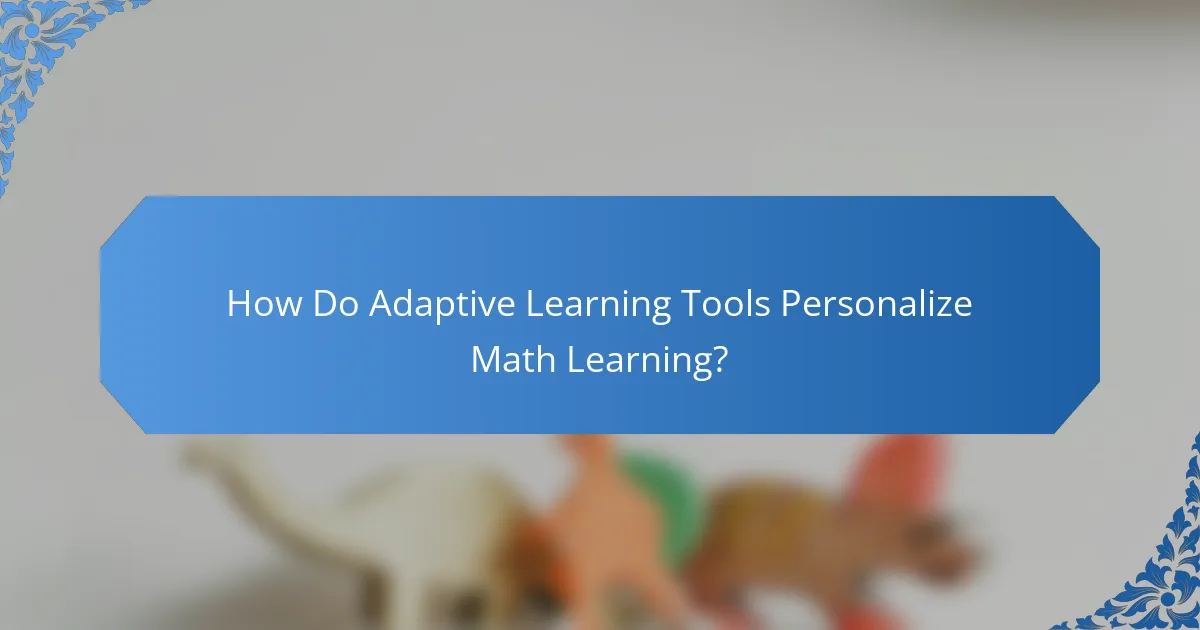
How Do Adaptive Learning Tools Personalize Math Learning?
Adaptive learning tools personalize math learning by analyzing individual student performance and tailoring educational content to meet their specific needs. These tools leverage data to create a customized learning experience that can enhance understanding and retention of mathematical concepts.
Data-Driven Insights
Data-driven insights are crucial for adaptive learning tools as they collect and analyze information on student interactions, performance, and progress. This data helps identify strengths and weaknesses, allowing educators to make informed decisions about instructional strategies. For example, if a student struggles with fractions, the system can highlight this area and provide targeted resources.
These insights can also reveal patterns in learning behavior, enabling educators to adjust their teaching methods accordingly. By understanding how different students engage with math content, teachers can better support diverse learning styles and needs.
Real-Time Feedback
Real-time feedback is a key feature of adaptive learning tools, providing immediate responses to student actions. This instant feedback helps students understand their mistakes and correct them on the spot, fostering a growth mindset. For instance, if a student answers a math problem incorrectly, the tool can offer hints or explanations to guide them toward the correct solution.
Additionally, real-time feedback allows educators to monitor student progress continuously. Teachers can quickly identify when a student is struggling and intervene as needed, ensuring that no one falls behind in their math education.
Customized Learning Paths
Customized learning paths are designed to cater to the unique needs of each student, allowing them to progress at their own pace. Adaptive learning tools create these paths by assessing a student’s current knowledge and skills, then recommending specific lessons and activities. This approach ensures that students are neither bored with material that is too easy nor overwhelmed by content that is too challenging.
For effective implementation, educators should regularly review and adjust these learning paths based on ongoing assessments. This flexibility helps maintain engagement and motivation, as students can see their progress and feel a sense of accomplishment as they master new concepts in math.
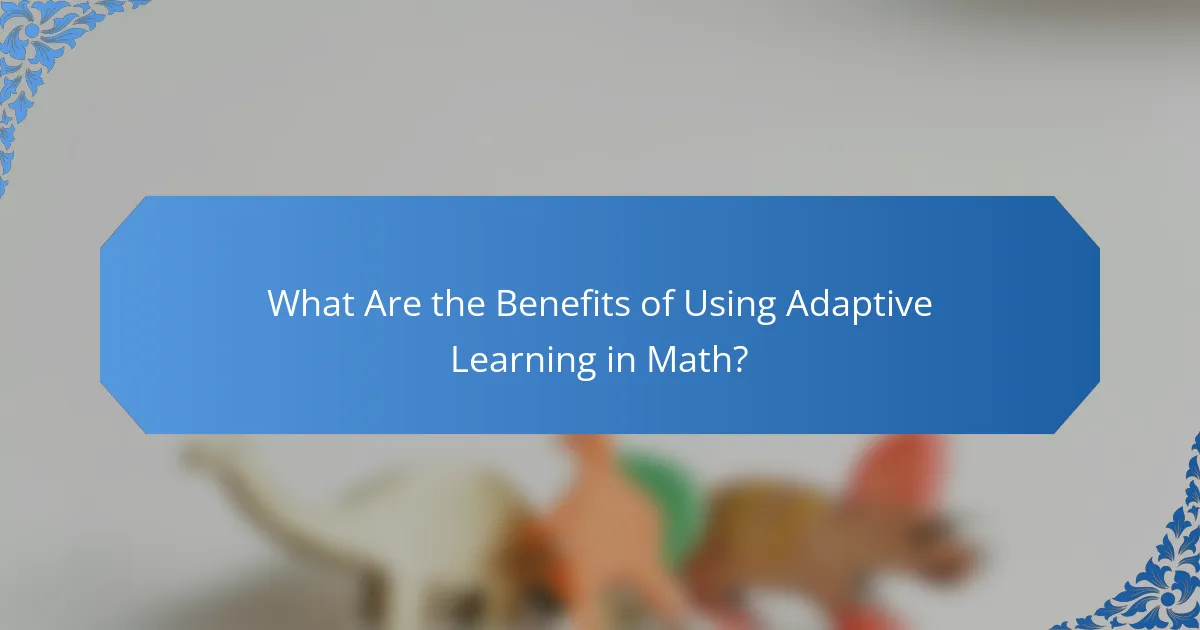
What Are the Benefits of Using Adaptive Learning in Math?
Adaptive learning in math offers personalized educational experiences that cater to individual student needs, enhancing engagement and improving learning outcomes. By utilizing technology to adjust content and pacing, these tools help students grasp mathematical concepts more effectively.
Improved Student Engagement
Adaptive learning tools significantly boost student engagement by providing interactive and tailored content. When students encounter challenges, the system adjusts to offer support, keeping them motivated and focused on their learning journey.
For instance, platforms may use gamification elements, such as rewards and progress tracking, to make learning math more enjoyable. This approach can lead to higher participation rates and a more positive attitude towards math education.
Enhanced Learning Outcomes
Students using adaptive learning tools often experience better learning outcomes compared to traditional methods. These tools assess student performance in real-time and modify the curriculum to address specific weaknesses, leading to a deeper understanding of mathematical concepts.
Research indicates that students may improve their test scores by significant margins when using personalized learning systems, as they receive targeted practice and feedback tailored to their unique needs.
Individualized Pace
Adaptive learning allows students to progress at their own pace, which is crucial for mastering math skills. Some learners may need more time to grasp certain concepts, while others may advance quickly through familiar material.
This individualized pacing helps prevent frustration and boredom, ensuring that students remain challenged yet not overwhelmed. Educators can monitor progress and adjust learning paths accordingly, fostering a more effective educational environment.
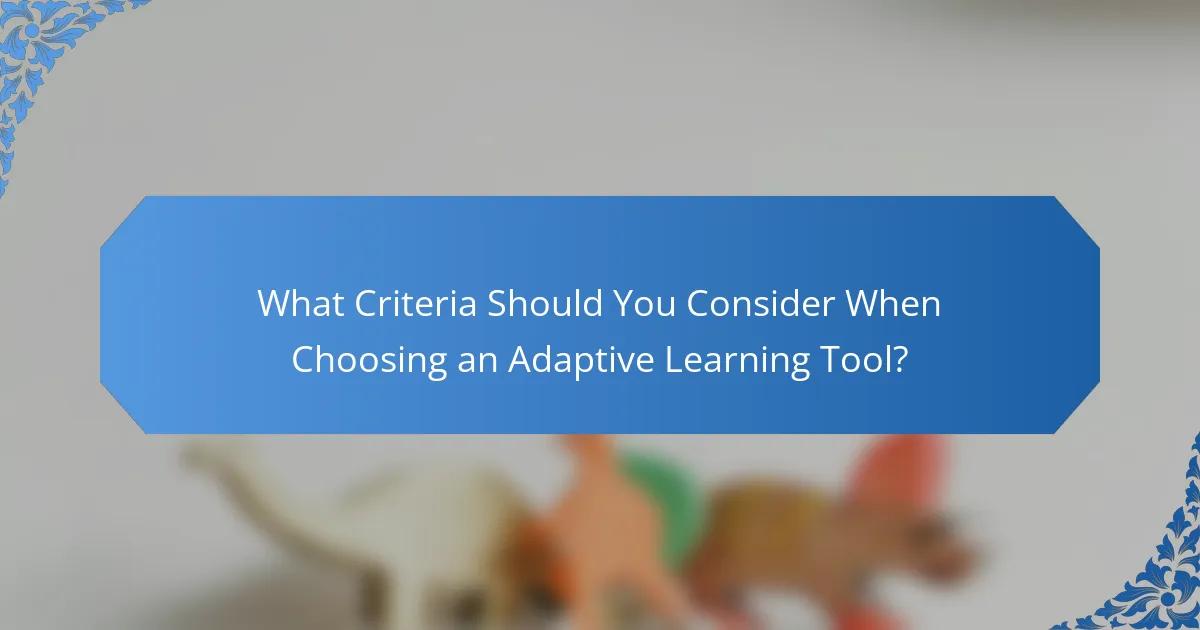
What Criteria Should You Consider When Choosing an Adaptive Learning Tool?
When selecting an adaptive learning tool for math education, consider factors like integration with your existing curriculum, user-friendliness, and cost-effectiveness. These criteria will help ensure the tool enhances learning without disrupting established teaching methods.
Integration with Existing Curriculum
Choose an adaptive learning tool that seamlessly fits into your current curriculum. It should align with educational standards and complement the topics already being taught, allowing for a smooth transition for both teachers and students.
Look for tools that offer customizable content or allow educators to upload their own materials. This flexibility ensures that the adaptive tool can be tailored to specific learning objectives and student needs.
User-Friendly Interface
A user-friendly interface is crucial for both students and teachers. The tool should be intuitive, allowing users to navigate easily without extensive training. Features like clear instructions, simple layouts, and engaging visuals can enhance the learning experience.
Consider tools that provide a demo or trial period, enabling you to assess usability before committing. A straightforward interface can significantly reduce frustration and increase student engagement in math activities.
Cost-Effectiveness
Evaluate the cost-effectiveness of adaptive learning tools by comparing their pricing models and features. Some tools may offer subscription-based pricing, while others might require a one-time purchase. Assess what fits your budget while still providing essential features.
Keep in mind any additional costs for training, support, or updates. A tool that appears inexpensive upfront may incur hidden costs that could impact your overall budget.

How Do Adaptive Learning Tools Compare in Pricing?
Adaptive learning tools vary significantly in pricing, influenced by features, user access, and subscription models. Understanding these differences can help educators and institutions choose the right tool that fits their budget and educational goals.
Knewton Alta Pricing
Knewton Alta typically operates on a subscription model, with pricing often ranging from $20 to $40 per student per month. This pricing includes access to a comprehensive suite of adaptive learning resources tailored for math education.
Institutions may benefit from bulk pricing options, which can lower the cost per student significantly. It’s advisable to contact Knewton directly for custom quotes based on the number of users and specific needs.
DreamBox Learning Pricing
DreamBox Learning offers a subscription model that generally costs between $5 and $10 per student per month, depending on the plan chosen. This platform is designed for K-8 students and provides personalized math instruction through engaging, interactive lessons.
Schools can explore different pricing tiers based on the number of licenses purchased, which may lead to discounts. Additionally, DreamBox often provides free trials, allowing educators to evaluate the tool before committing financially.
IXL Learning Pricing
IXL Learning’s pricing structure is based on a subscription model, with costs typically ranging from $20 to $30 per student annually. This includes access to a wide range of math practice problems and personalized learning paths.
IXL also offers school-wide licenses, which can provide significant savings for larger institutions. It’s beneficial for schools to assess their specific needs and student numbers to determine the most cost-effective option.
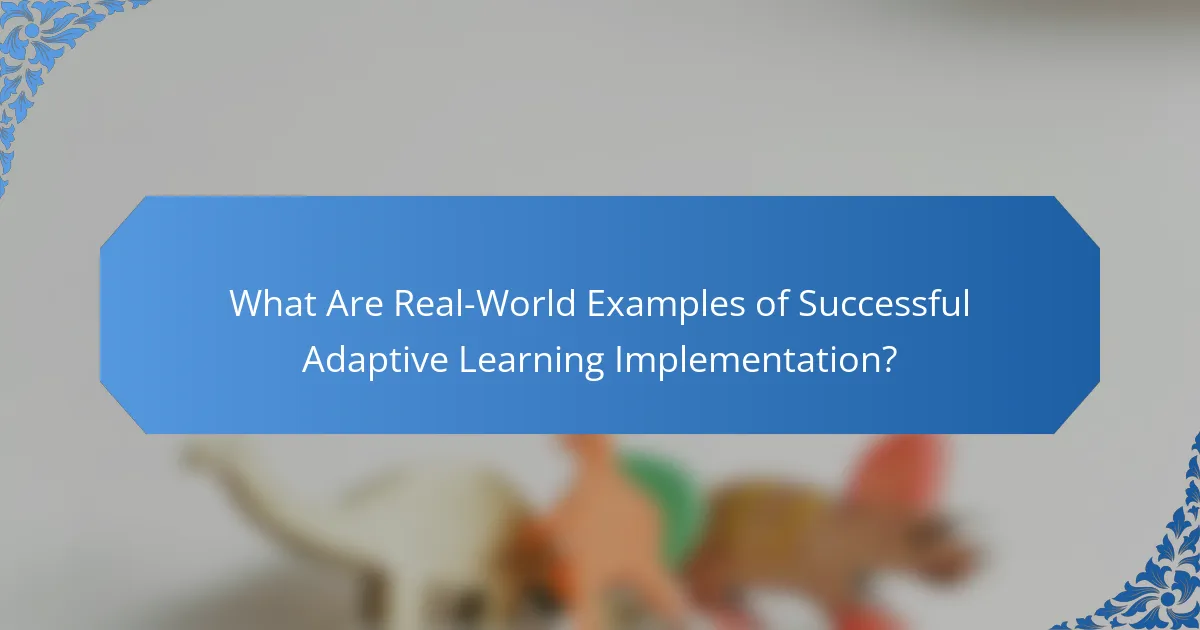
What Are Real-World Examples of Successful Adaptive Learning Implementation?
Successful adaptive learning implementation in math education can be seen in various educational institutions and platforms that tailor instruction to individual student needs. These examples highlight the effectiveness of personalized approaches in enhancing student engagement and achievement.
Khan Academy
Khan Academy utilizes adaptive learning technology to provide personalized math instruction. The platform assesses students’ skills and tailors practice exercises accordingly, ensuring that learners progress at their own pace. This method has helped millions of students improve their math proficiency through targeted practice and immediate feedback.
DreamBox Learning
DreamBox Learning is an adaptive math program designed for K-8 students. It adjusts the difficulty of problems based on real-time student performance, offering hints and scaffolding as needed. Schools using DreamBox have reported significant gains in student math scores, demonstrating the effectiveness of its personalized approach.
IXL Learning
IXL Learning offers a comprehensive adaptive learning platform that covers various subjects, including math. The program provides personalized recommendations based on student performance, allowing for targeted skill development. Educators appreciate IXL’s analytics, which help track student progress and identify areas needing improvement.
Smart Sparrow
Smart Sparrow focuses on adaptive elearning solutions for higher education, including math courses. Its platform allows instructors to create personalized learning experiences that adapt to student interactions. By using real-time data, Smart Sparrow enhances engagement and retention, leading to better learning outcomes.
Carnegie Learning
Carnegie Learning combines adaptive learning with research-based instructional strategies in its math curriculum. The program adjusts content based on student understanding and provides teachers with insights to inform instruction. Schools implementing Carnegie Learning have seen improvements in student achievement and engagement levels.
